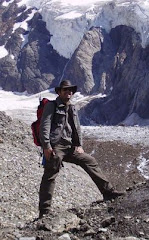The understanding of the movement of rock glaciers is of major interest in periglacial geomorphology, particularly considering the potential response of ongoing climatic warming trends, and changing temperature regime within the ice-rock mixture. Direct observation of the internal deformation with boreholes is time consuming, logistic complex and so expensive.
Anyway the conducted surveys showed that most of horizontal movements are concentrated in spatially delimitated “shear zones”, so the movement of surface is still a good approximation of the internal movement.
Remote sensing methods are nowadays widespread tools for environment and geological research. These methods can survey large areas, providing large data masses at low costs.
Photogrammetry adopted on various, mostly Swiss, rock glaciers, represents the best technology for monitoring the superficial deformation. Within this approach air-photos of different ages are compared and the displacement of single marker points – for example large boulders- traced and mapped.
Differential Synthetic Aperture RADAR Intereferometry (D-InSAR), a satellite based remote sensing, is still to be evaluated and calibrated by ground-based methods. An important historic method was and is the triangulations of points by the use of a theodolite from a fix point.
Anyway the conducted surveys showed that most of horizontal movements are concentrated in spatially delimitated “shear zones”, so the movement of surface is still a good approximation of the internal movement.
Remote sensing methods are nowadays widespread tools for environment and geological research. These methods can survey large areas, providing large data masses at low costs.
Photogrammetry adopted on various, mostly Swiss, rock glaciers, represents the best technology for monitoring the superficial deformation. Within this approach air-photos of different ages are compared and the displacement of single marker points – for example large boulders- traced and mapped.
Differential Synthetic Aperture RADAR Intereferometry (D-InSAR), a satellite based remote sensing, is still to be evaluated and calibrated by ground-based methods. An important historic method was and is the triangulations of points by the use of a theodolite from a fix point.
In the last years the use of the Global Positioning System (GPS) has acquired importance. The development of light, easy to carry and use receivers, the use of a fixed base point that allows high precision measurements, has gathered this method high acceptance and use in difficult terrain.
GPS is based on the distance measurements between several satellites and a receiver. Only one receiver allows an accuracy of few meters, depending of the quality of the satellite signal. The accuracy is strongly improved by the use of a second receiver – the reference- set up at a fixed point, that measuring his position several times and so compensating the “noise”.
During the measurement of the surface the second receiver – the rover- is moved, and comparing his relative position to the reference.


References:
CHESI, G.; KRAINER, K.; WEINOLD, T. & MOSTLER, W. (1999): Bewegungsmessungen am aktiven Blockgletscher Inneres Reichenkar mit der GPS-Methode. X. Int. Geodätische Woche Obergurgl: 223-227
CHESI, G.; GEISSLER, S.; MOSTLER, W.; KRAINER, K. & WEINOLD, T. (2003): 5 Jahre Bewegungsmessungen am aktiven Blockgletscher Inneres Reichenkar (westliche Stubaier Alpen) mit der GPS - Methode.XII. Internationale Geodätische Woche Obergurgl 2003: 201-205
FONTANA, T. (2007): Bewegungsmessung von Blockgletschern mittels GPS. Diplomarbeit,. Fak. Für Bauingenieurwissenschaften, Univ. Innsbruck.
LAMBIEL, C. & DELALOYE, R. (2004): Contribution of real-time kinematic GPS in the study of creeping mountain permafrost: Examples from the Western Swiss Alps. Permafrost and Periglacial Processes 15(3): 229-241





Keine Kommentare:
Kommentar veröffentlichen